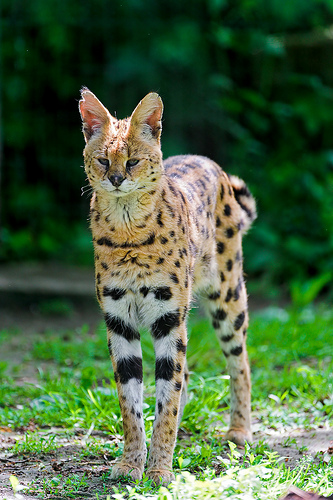Servals, worshipped by Ancient Egyptians.
- Servals are 19 subspecies of cat-like mammals native to Africa’s savannah habitats, south of the Sahara desert.
- A ‘serval’ is also known as a ‘bush cat’, a ‘tiger bush cat’ and a ‘giraffe cat’.
- Servals have the scientific name Leptailurus serval, although they are the only species in the Leptailurus genus, and they are from the family Felidae, the family of felids or cats.
- Servals are most active during the night, when they hunt mostly for rodents, although they also consume birds, reptiles, frogs, insects, fish, hares and hyraxes, and they eat the meat and bones.
- Servals have the longest legs of any cat in proportion to the animal’s body size, and the legs are used for jumping a height of 2 to 3 metres (7 to 10 feet) and they can run at top speeds of at least 64 kilometres/hour (40 miles/hour).
A Serval
Image courtesy of Tambako the Jaguar/Flickr
- Vocalisation among servals includes purrs, hisses, chirps, growls and meows, although meeting with others of the same species often results in fights as they are generally solitary animals.
- Female servals have litters of one to four blind cubs, most often two, and they can have more than one litter in the year.
- Servals, although they are classified as ‘least concerned’, have declined in numbers due to poaching and habitat loss.
- Servals are typically coloured a yellow-orange to brown colour, with dark spots that pattern their coat, and they have very large ears compared with their head, that have distinct markings on the back.
- Servals are occasionally preyed on by leopards and hyenas, while their lifespan is 10 to 20 years, and they can even reach up to age 23.
Bibliography:
Serval, 2013, A-Z Animals, http://a-z-animals.com/animals/serval/
Serval, 2014, San Diego Zoo, http://animals.sandiegozoo.org/animals/serval
Serval, 2014, Wikipedia, http://en.wikipedia.org/wiki/Serval







